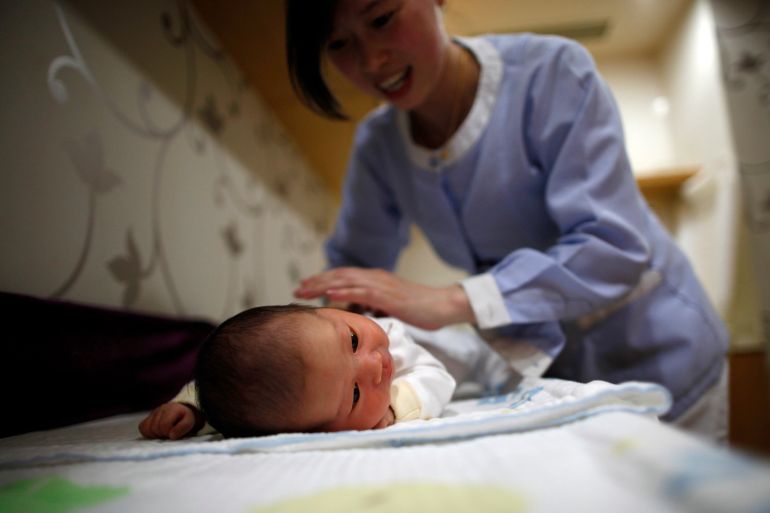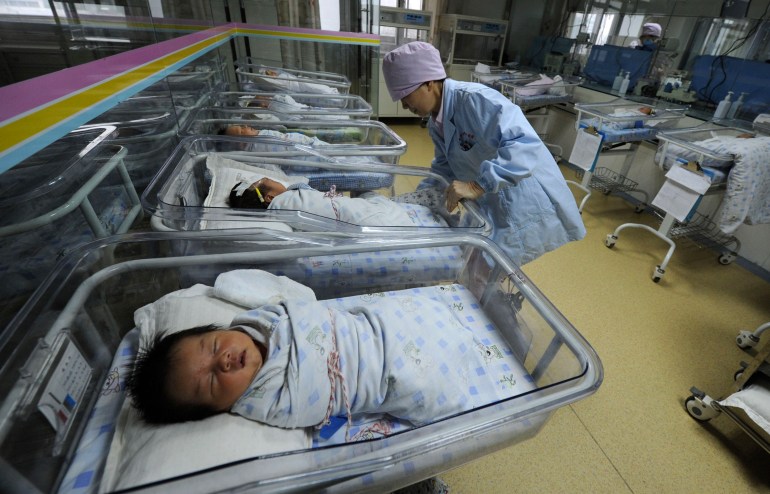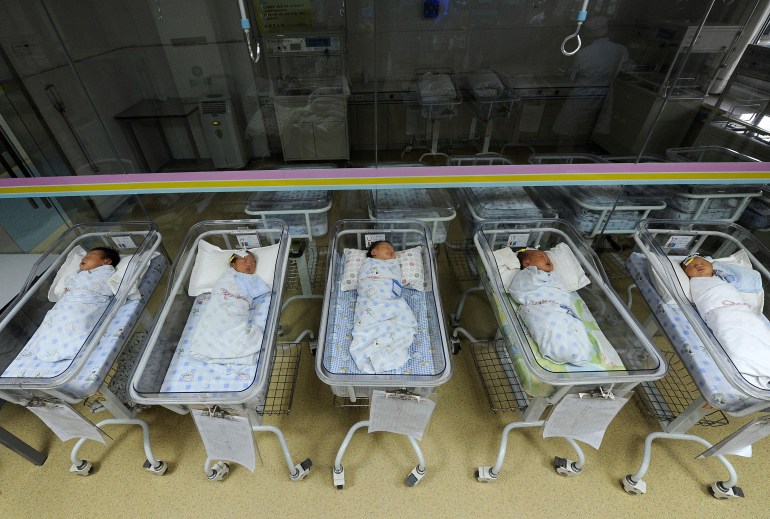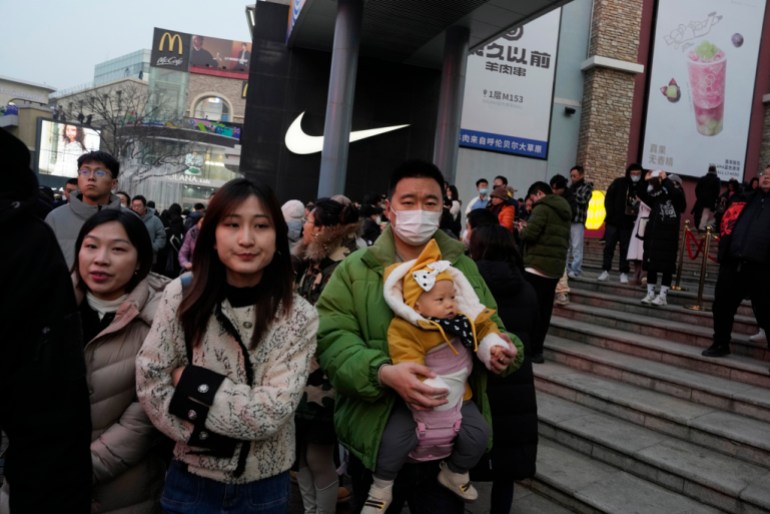‘Obstetric winter’: Why are China’s hospitals shutting delivery wards?
China’s birthrate is falling and hospital maternity departments across the country are closing, according to reports.

Medical experts and Chinese media are reporting on the closure of obstetric departments across this country of 1.4 billion people, which has suffered a population decline for two consecutive years – China’s first experience of a diminishing birthrate in several decades.
The closures of delivery wards has been likened to an “obstetric winter” in China, while public concern around the shutdowns has prompted authorities to remove search topics related to the issue from Chinese social media.
Keep reading
list of 4 itemsAs China ages, senior citizens see a retirement of striving to get by
World watches as China sets out priorities for 2024
China to introduce new policies to tackle ageing population
But the silencing of public concern has not stopped Chinese hospitals from closing their delivery wards.
China’s economy is struggling and as young people eschew traditional marriages and having children, the prospect of rekindling population growth in China appears bleak.
Here’s what we know about the closure of China’s obstetrics departments.

Fewer Chinese women are having children
China’s National Bureau of Statistics announced in February that the country’s population fell for a second year in a row in 2023 – dropping by 2.08 million to 1.409 bn.
Last year’s decline was far more than the decline recorded in 2022 of 850,000, which marked the first time China’s population had reduced since 1961 – the year of the Great Famine under the leadership of Mao Zedong.
Figures for 2023 also showed that new births fell 5.7 percent – to 9.02 million – and the country’s birthrate also hit a new low of 6.39 births per 1,000 people, down from 2022’s rate of 6.77 births per 1,000.
The birthrate in China has been falling since the imposition of a strict one-child policy for families in 1980 amid fears of a rapidly rising population. Amid an equally sharp fall in population, the Chinese government changed course in 2015, allowing couples to have two children, then three children in 2021.
But allowing couples to have more children has not resulted in more choosing to do so.
Several explanations have been given for why Chinese people appear unwilling to have more children, including: The effectiveness of decades of government messaging around the benefits of limiting family size to one child. The economic costs associated with having children in China – childcare, education, healthcare – and the effects on the careers of young people from having families.
How many hospitals have closed obstetric departments?
China has not published official figures on the reported closures.
The Reuters news agency reported this week that “many hospitals in China” had stopped offering obstetric services this year.
Data from China’s National Health Commission shows the phenomenon is not sudden. Between 2020 and 2021, the number of maternity hospitals fell from 807 to 793, according to Reuters.
“The ‘obstetric winter’ seems to be coming quietly”, China’s Daily Economic News media outlets reported last week. But, alarm bells have been sounding for longer than that among Chinese medical experts and media reports.

In September, The Paper – a state-run digital media organisation based in Shanghai – published a lengthy report on the closure of obstetric departments, including in Zhejiang province’s Ningbo and Wenzhou cities, Jiangsu province, the Guangxi region, and Guangzhou city in Guangdong Province.
Many hospitals in Guangdong had also adjusted their obstetrics and gynaecological services, according to The Paper, such as reduced work hours, including no coverage overnight, and reducing what care could be provided at other times.
Criticism of the closures
In an opinion piece published by China Business News in February, Professor Deng Yong of the Beijing University of Chinese Medicine, and Wang Chongyu, also of the same university, warned against the “rapid abolition” of paediatric and gynaecological departments in China.
“The reasons behind this phenomenon and the social and medical problems exposed urgently need to be discussed and solved by all sectors,” they wrote in their lengthy analysis of the unfolding situation and their argument for keeping obstetric departments open.
“According to media reports, obstetrics departments across the country are experiencing a ‘cold winter’ and the number of newborns continues to decrease,” they said.
“Although the abolition of paediatric hospitals and maternal and child hospitals seems to have become a general trend, their rapid abolition will affect the supply of basic medical care for citizens, increase the strain on hospital resources, and trigger a series of social problems,” they continued.
“If there are not enough paediatric, maternal and child hospitals to provide medical services, pregnant women and infants will not be able to receive professional medical treatment, and the consequences will be disastrous.”
Chinese women’s changing expectations
Stuart Gietel-Basten, professor of social science at Hong Kong University of Science and Technology and an expert on population policy, said China’s demographic changes were being reflected in the health sector, noting that as obstetric services decrease those required for an ageing population will increase.
Why fertility remains so low in China involves issues now common to women around the world, Gietel-Basten told Al Jazeera.
“What we need to do is recognise the fundamental challenges of getting started in life for young people in China, and in many other parts of the world, in terms of the cost of housing, decent employment, stable employment,” he said.

According to Gietel-Basten, young women in China face myriad risks to their career and economic wellbeing from having a family, not to mention an “uneven burden of care” in the home as women are expected to look after children, parents and parents-in-law.
“The costs for women in terms of the economic risk, but also the risk to having the kind of life that they want, and would expect to have, is very, very great,” he said.
Chinese attitudes to marriage and children
The number of people getting married in China fell from approximately 13.5 million couples annually in 2013 to approximately 6.8 million in 2022.
Data indicates that Chinese people are also getting married later, divorce rates are rising, and the number of people choosing to remain single is growing.

Agnes Chen, 34, a business owner in Shanghai, told Al Jazeera she was not surprised that obstetric departments are scaling back across China.
“Now is not a good time to have a kid. The economy is not good, and a lot of young people are struggling and have other priorities,” she said. “Even the couples I know that want to have a kid are waiting for better times instead.”
Lisa Ming, 28, a nurse anaesthetist in Shenzhen, said she had often discussed starting a family with her husband after they married last year.
“But we don’t have a lot of money right now so we have decided to wait and see what happens, and what we want in the future,” she told Al Jazeera.
“We would have to work a lot more to provide for a baby, and we don’t want more stress and pressure right now. Life is not just about starting a family, quality of life is also important,” she said.
“So for now, we just have a cat.”
Additional reporting by Frederik Kelter.